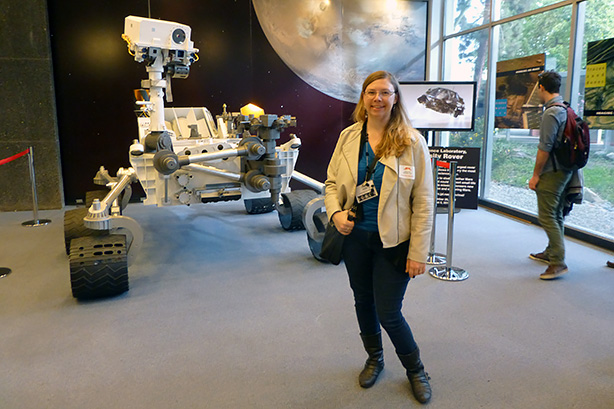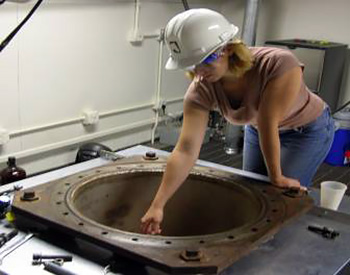
Jennifer Hanley '06 with a model of the Mars Curiosity Rover at NASA's Jet Propulsion Laboratory in California. Photo: provided.
Alumna's research leads to planetary water discoveries
Jennifer Hanley '06 just began a new position at the Lowell Observatory in Arizona, shifting her attention from Mars to Pluto and a moon of Saturn, but she's still focused on one goal – the search for water.
Hanley was one of eight authors of a paper, published in the Sept. 28, 2015 issue of Nature Geoscience, on the discovery that liquid water appears to exist on Mars.

At the University of Arkansas, Hanley conducted experiments on salt solutions in the university's Mars simulation chamber. Photo: provided.
As a postdoc at Southwest Research Institute 2013-15, Hanley evaluated data from the Mars Reconnaissance Orbiter that showed dark lines called recurring slope lineae, sometimes caused by the flow of salty water. Using new detailed spectroscopy from the orbiter and in her lab, Hanley determined a certain type of chlorine salt exists on the planet, salt that couldn't be present without water.
"Science is a game of incremental progress," says Hanley, who majored in science of Earth systems as an undergraduate in the College of Arts and Sciences. "We want to find liquid water because that's what life uses, and knowing that there are salts there implies that there's been liquid water."
Her new position will enable her to do similar research on very low temperature exotic ices made of nitrogen, carbon monoxide and carbon dioxide, she says. Such ices might exist on other planets or moons, including Pluto and Titan, the largest moon of Saturn.
"There are lakes of organics on Titan, but we don't know if those lakes and rivers – which seem to fill due to a rain cycle analogous to the water cycle on Earth – if something could have evolved to live in those places," she says."
Hanley said she has been fascinated with space ever since she was a kid and thought she would grow up to be an astronaut. She entered Cornell as an astronomy major but soon found she was more interested in studying planets than "extragalactic astronomy or stars."

Hanley at the top of McGraw Tower on the Cornell campus. Photo: provided.
She found a good fit in the science of Earth systems major, where "you're looking at Earth as a planet along with people from geology, physics, chemistry and all of the science fields," she says. What she learned about Earth, she says, is applicable to most any other planet.
Between her junior and senior years at Cornell, Hanley was chosen for a Research Experience for Undergrads (REU) program at the University of Arkansas, where she conducted experiments on salt solutions in the university's Mars simulation chamber.
Back on campus as a senior, she did an independent study on the possibility of water on Mars with Peter Gierasch, professor of astronomy, who specializes in planetary atmospheres.
"I thought it was great how approachable professors were at Cornell," she says. "That's how I got the research position in my sophomore year,Ó and she noted that her astronomy professors wrote letters of recommendation for her for the REU program.
Hanley says she's also thankful for the other classes she took as an Arts and Sciences student.
"It helped to break up the really hard science classes and stretched a different part of my brain," she recalls, remembering favorites like intro to acting, wines, philosophy and psychology courses.
As Hanley moves forward in her research, she says she hopes her work might lead NASA to take a giant step.
"The thing that would be most exciting to me would be to see humans go to Mars and explore," she says. "Even though there are many things that a rover can do, there's so much more that a human can do."
Has Hanley seen the new movie, "The Martian?" Oh, yes, and she read the book too. She'd highly recommend it.
"There are a few liberties taken to set up the story, but it's mostly realistic," Hanley says. "A lot of the technology used in the movie is actually currently being developed by NASA."